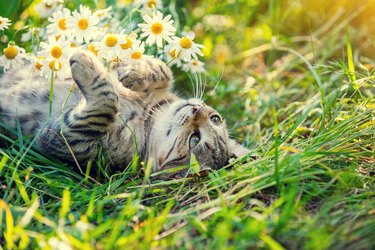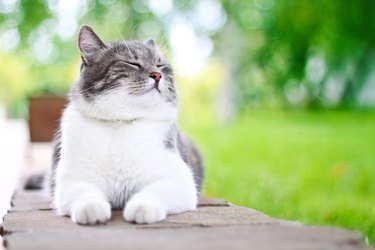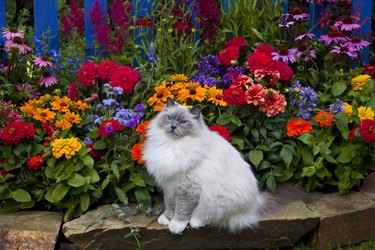Cats and certain plants don't mix. If you are getting a new cat or kitten, take the time to go through your house and make sure all of the houseplants you have are safe for your cat. For example, the anthurium plant is toxic to cats and dogs. You might not know the name anthurium, as the plant is colloquially known as the flamingo flower or lily, the painter's palette, the lace leaf, the pigtail plant, the oilcloth flower, and the tail flower.

Video of the Day
What are anthurium plants?
Anthurium plants are perennials that are often selected for their beautiful foliage. There are many species and varieties of anthurium. A few examples include:
Video of the Day
- Anthurium andreanum has green heart-shaped leaves and colorful bracts.
- Anthurium crystallinum has green leaves and white veins.
- Anthurium luxurians has green heart-shaped leaves with ridges.
- Anthurium scherzerianum has green leaves and colorful bracts.
- Anthurium veitchii has large green lanceolate-shaped leaves with ridges.
- Anthurium warocqueanum has dark green leaves and white veins.
Identifying anthurium plants in a home with pets
Anthurium plants bring a tropical touch to your home, but these toxic plants will need to go to keep your cat safe. If you have had a plant for a long time, you may not remember what species it is. You can identify anthurium by examining its characteristics.
The anthurium, or flamingo lily, is an upright plant with multiple stems. It can grow up to 3 feet tall. It has dark green smooth, heart-shaped leaves that have a leathery feel. It has a spadix, or spike, of small green, yellow, or white flowers. The spike of flowers is surrounded by a large red spathe, or a leaflike structure. If you have this plant in your home, give it to someone who doesn't have cats or dogs.

Flamingo flower toxicity to cats
All parts of the flamingo lily are toxic to cats. This includes the stem, flowers, seeds, leaves, and roots. Insoluble calcium oxalate crystals in the plant cause the reaction.
Is anthurium safe for dogs? No, the flamingo flower is toxic to humans and other pets, including dogs and horses. It can also cause contact dermatitis from touching the plant.
Signs that your cat has eaten a toxic plant
If your cat ingests or chews any part of the plant, flaming flower toxicity will cause oral irritation, mouth pain, and swelling of the lips and tongue. You may notice symptoms such as:
- Pawing at the face
- Drooling
- Meowing in pain
- Loss of appetite
- Difficulty swallowing
- Vomiting
In severe cases, the cat could have difficulty breathing because their throat has swollen shut and blocked the airway. This is rare but can be life-threatening.
What to do if a cat eats anthurium
If you suspect your cat has eaten any part of this plant, get help right away. Remove them from the plant and take them to a safe location. Don't wait to see if symptoms worsen. If your cat ingested a large amount of the plant, the sooner your veterinarian can induce vomiting and administer other treatments, the better. Call the Pet Poison Helpline or take them to the veterinarian immediately.
Do not feed your cat or try any home remedies to induce vomiting unless instructed to do so by a veterinarian. This includes any food, milk, or oil. Take a sample of the plant with you to the veterinarian so that they can confirm the identity of the plant and that it is the source of the problem.

Create a safe environment for cats
Cats are known for their ability to jump onto shelves and other high places they want to explore. While you may be able to move a toxic plant out of reach of a dog, this is much more challenging when you have a cat. The best option is to simply remove all poisonous plants from your home to be safe.
It is also always a good idea to have a well-stocked first-aid kit on hand for your pet. Pet Poison Helpline has recommendations for what to include in your kit. Also, make sure you have phone numbers and directions to your veterinarian and a local emergency veterinary clinic just in case.
Alternative cat-safe houseplants
You may not be able to safely keep anthurium in your home, but you can still enjoy the foliage of pet-safe indoor plants. Some examples of safe houseplants with beautiful foliage include:
- Spider plant
- Boston fern
- Cast iron plant
- Parlor palm
- Calathea plants
- Chinese money plant
- Banana tree
You can also consider pet-safe flowering houseplants to bring a splash of color to the room. Some options include:
- African violet
- Gerbera daisy
- Lace flower vines
- Bromeliads
If you are uncertain if a plant is safe for pets, call the ASPCA's animal poison control number at (888) 426-4435, check the ASPCA's list of toxic and nontoxic plants or consult your veterinarian.
The bottom line
The anthurium plant is toxic to cats and can cause symptoms like drooling, pawing at the face, loss of appetite, and vomiting. Take your cat to the veterinarian right away if your cat eats any part of the plant. Keep your cat safe by removing this and any other toxic plant from your home and replacing it with a pet-safe option, like a spider plant or Boston fern.